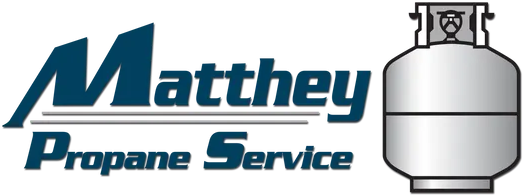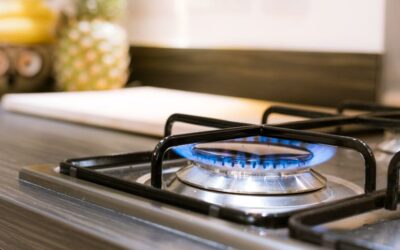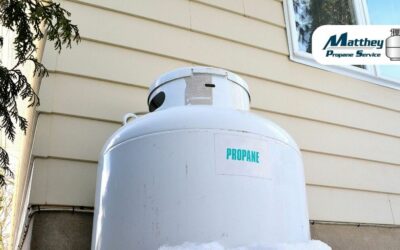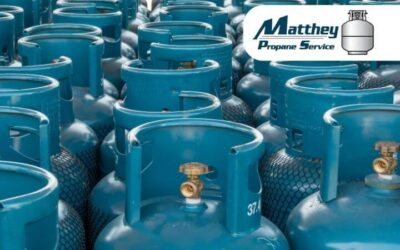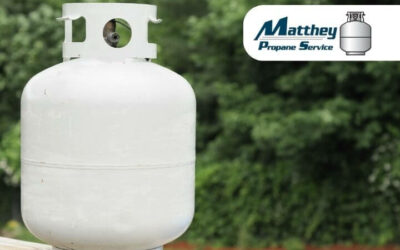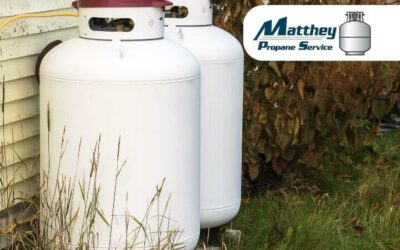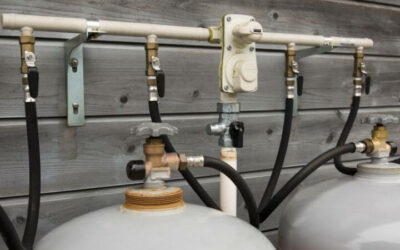Understanding Propane and Its Safe Storage
Propane, or liquefied petroleum gas (LPG), is a widely used fuel source in homes and businesses across the globe. Its popularity stems from its efficiency, cost-effectiveness, and minimal environmental impact. However, despite its benefits, propane can pose significant risks if not stored correctly, including the potential for fires or explosions. Matthey Propane Service, a specialist in Propane, underscores the gravity of adhering to safety protocols while handling this volatile fuel source.
In this section, we delve into the fundamentals of propane, emphasizing the importance of safe storage and the potential dangers of mishandling this fuel source. The cornerstone of safe propane storage lies in understanding its properties, such as its physical characteristics, flammability, and sensitivity to temperature fluctuations. By gaining this knowledge, you can implement safety measures that prevent accidents and ensure propane is used safely and efficiently.
Proper Propane Containers
Effective propane storage begins with choosing the right container. Propane tanks, the most common type of propane container, are designed to safely hold and dispense propane. While all tanks are built to withstand the pressure of the gas, their construction and design can vary to accommodate different needs.
Your choice of container should be guided by your usage needs, the volume of propane you plan to store, and your disposal methods. Options range from small, portable canisters perfect for barbecues or camping stoves, to larger, permanent tanks for home heating or business operations.
When selecting a tank, consider factors such as compliance with safety standards, durability, ease of access, and resistance to harsh weather conditions. For instance, if you live in a region with severe winters, a tank that can withstand extreme cold would be a wise choice.
Remember, improper handling or storage of propane can have severe consequences. Therefore, investing in the right propane container is a crucial step towards ensuring safety and achieving optimal performance.
Selection Criteria for Propane Containers
Choosing the right propane container involves careful consideration of several key factors. Size is the first aspect to consider. The capacity of your tank should align with your projected propane usage. For instance, a 500-gallon tank usually suffices for home use, while larger businesses may require tanks with a capacity of 1,000 gallons or more.
Material quality is another critical consideration. Propane tanks are typically constructed from high-grade steel, designed to withstand pressure and resist corrosion. It’s worth noting that tanks manufactured overseas may use inferior steel, which could compromise safety. As such, it’s advisable to invest in a tank made from domestically-sourced, high-quality steel.
The design of the tank is the third factor to consider. Premium propane tanks adhere to a standard design, equipped with a pressure relief device and a liquid withdrawal valve for safe propane management. A well-designed tank should also include an overfill prevention device that automatically halts filling once the propane level hits 80%, thus preventing overfilling.
Lastly, consider the reputation of the manufacturer. Trustworthy manufacturers adhere to safety and quality regulations, ensuring their tanks meet or exceed national standards. It’s important to conduct thorough research on the manufacturer before purchasing to ensure their product is reliable and compliant with quality standards.
Regulations Governing Propane Storage
Given its highly flammable nature, propane storage is subject to stringent regulations. Regulatory bodies like the National Fire Protection Association (NFPA) and the U.S. Department of Transportation (DOT) have established guidelines outlining safe storage practices to prevent accidents.
These regulations encompass a wide array of aspects related to propane storage, including the design and construction of propane tanks, criteria for safe storage locations, installation procedures, maintenance practices, and emergency procedures.
Local government units often impose additional specific codes and regulations that users must comply with. Ignoring these laws can lead to hefty fines and, more critically, can endanger your property and its surroundings.
Understanding and adhering to these regulations is crucial for both residential and commercial propane users. Compliance is not just a legal requirement but a safety imperative. The following sections of this article will provide detailed guidance on some of these regulations.
Understanding Propane Storage Laws
Propane storage laws are a critical safety net, designed to mitigate the inherent risks of propane usage. These regulations are primarily established by authoritative bodies such as the National Fire Protection Association (NFPA) and the U.S Department of Transportation (DOT), and are often complemented by local and state-specific rules.
A central regulation to be aware of is the NFPA 58, or the Liquefied Petroleum Gas Code. This extensive guide provides a blueprint for the safe handling, storage, and usage of propane. It offers detailed instructions on the construction of propane containers, their maximum weight and capacity, and the safe distances that propane tanks should maintain from buildings, property lines, ignition sources, and other tanks.
The DOT also contributes to these safety measures, providing guidelines on the transportation of propane and other hazardous materials. These rules pertain to the design, construction, and testing of propane delivery trucks and cylinders.
It is incumbent upon propane users, especially businesses, to familiarize themselves with these laws and ensure their strict adherence. Regular training for staff and staying updated with any changes in these laws is advisable. Non-compliance can lead to penalties and, more critically, can pose a threat to lives and property. Collaborating with a trustworthy propane service provider, well-versed with these regulations, can be beneficial in ensuring compliance.
Safe Placement and Installation of Propane Tanks
Ensuring the safe placement and installation of propane tanks is a pivotal step in promoting safe and efficient propane usage. These two aspects significantly reduce the potential hazards associated with propane storage, such as leaks, fires, and explosions.
The placement of the tank requires careful consideration of several factors. These include maintaining safe distances from buildings, property lines, ignition sources, and other tanks. It also necessitates ensuring easy access for deliveries and maintenance, and the absence of any obstructions that could impede emergency response.
On the other hand, the installation process must align with the guidelines set forth by regulatory bodies like the NFPA and DOT. These guidelines encompass elements such as pressure relief devices, overfill prevention devices, and grounding measures. The process also involves connecting the tank to the building, conducting tank and piping pressure tests, and carrying out inspections.
The upcoming sections will delve deeper into these areas, providing comprehensive guidance on adhering to best practices for safe propane storage. It is crucial to remember that the placement and installation of propane tanks should be entrusted to a licensed professional to ensure full compliance with all laws and regulations.
Proper Location for Propane Tanks
The placement of your propane tank is a crucial factor in ensuring the safe and efficient use of your propane system. Here are some key considerations to keep in mind when deciding where to install your propane tank:
Safe Distance from Structures and Ignition Sources: It’s essential to maintain a safe distance between your propane tank and any structures, such as your home or outbuildings. For residential tanks, a minimum of 10 feet is recommended, while larger commercial tanks should be at least 25 feet away from any property. Additionally, your tank should be positioned well away from potential ignition sources, including air conditioning units and electrical outlets.
Accessibility: The location of your tank should not hinder your propane provider’s ability to access it for refilling and maintenance. The chosen spot should be easily reachable by the delivery truck and facilitate a straightforward refilling process.
Propane Tank Size: The size of your tank should be in proportion to the space available. Larger tanks will naturally require more room.
Ventilation and Drainage: Your tank should be situated in a well-ventilated area to allow any leaked gas to disperse quickly. Additionally, the area around the tank should have good drainage to prevent water buildup.
Local Regulations: Be sure to check with your local authorities to understand any specific restrictions or codes related to propane tank placement in your area.
Remember, these guidelines are a starting point. Always consult with a licensed professional to ensure all safety measures and regulations are met when deciding on the final placement of your propane tank.
Installation Guidelines for Propane Tanks
The correct installation of a propane tank is a critical step in maintaining the safety and efficiency of your propane system. This process should always be carried out by a certified professional who is familiar with the specific requirements and regulations. Here are some key guidelines to keep in mind:
Ground Preparation: The ground where the tank will be placed should be prepared appropriately. Above-ground tanks require a level and firm surface, while underground tanks need a sufficiently deep and wide hole.
Tank Positioning: The tank should be positioned so that the pressure relief valve is directed away from any buildings. Above-ground tanks should be elevated on stable bases, such as slabs or pads, to prevent corrosion from ground moisture.
Component Installation: Safety components, including pressure relief devices and overfill prevention devices, should be installed correctly. These devices help maintain the gas pressure inside the tank and prevent overfilling.
Piping: The piping should be securely fastened using approved materials and protected against potential damage, such as impacts or corrosion.
Leak and Pressure Testing: After the tank is installed, a leak test should be conducted to verify the integrity of the tank and its connections. A pressure test should also be performed to ensure the tank can safely handle the pressure of the propane.
Regulatory Compliance: The installation process must adhere to all local and national regulations. A professional can guide you through these regulations to ensure compliance.
Documentation: Keep detailed records of the installation, including the date, the person who installed the tank, and the results of the safety tests. This information can be helpful in troubleshooting any future issues.
While these guidelines provide a roadmap for safe propane tank installation, remember that professional installation is strongly recommended to ensure compliance with all relevant laws and regulations.
Maintaining Your Propane Tanks
The longevity and safety of your propane tanks hinge on regular and meticulous maintenance. When appropriately cared for, these tanks can serve you for several decades, delivering propane efficiently and safely to your premises.
Maintenance involves a two-pronged approach: regular inspections and routine upkeep tasks. Inspections help identify potential issues early, allowing for prompt resolution and averting more serious, costly problems down the line. On the other hand, upkeep tasks range from simple activities like keeping the tank area clear of debris to more complex ones such as checking the tank’s integrity and testing pressure levels.
While some tasks can be performed by users, it’s advisable to leave most of the maintenance work to professionals. These experts are equipped to handle complex tasks and ensure safety when dealing with this type of fuel source. In the subsequent sections, we’ll delve into the specifics of regular tank inspections and maintenance tasks to give you a better understanding of how to effectively maintain your propane tanks.
Regular Propane Tank Inspections
Consistent inspections of your propane tank are a cornerstone of effective maintenance, playing a pivotal role in ensuring safe operation. While some checks can be performed by the tank owner, it’s recommended that a qualified service technician conduct most inspections to guarantee safety and regulatory compliance. Here’s a rundown of what a typical propane tank inspection entails:
- Exterior Inspection: This involves a visual check for external damage, rust, or leaks. Any anomalies should be reported to your propane provider immediately.
- Pressure Relief Valve: This valve releases excess pressure from the tank and should be inspected for proper functioning.
- Valves and Fittings: These should be checked for signs of wear, damage, or leaks.
- Tank Structure: Look out for signs of bulging, a red flag indicating a serious issue that necessitates immediate professional intervention.
- Propane Quality: Check the propane for signs of water contamination or debris, which can damage your propane appliances if not addressed.
- Propane Level: Regular monitoring of your propane level can prevent fuel shortage and help detect leaks.
- Leak Testing: A qualified technician should perform regular leak tests to ensure there are no hidden leaks posing a safety risk.
- Cathodic Protection: For underground tanks, the cathodic protection system, which prevents rusting, should be tested regularly by a technician.
In essence, regular inspections are a proactive measure to ensure the longevity and safety of your propane storage system. Always enlist the services of a certified professional for comprehensive inspections and any necessary follow-up actions.
Propane Tank Maintenance Tasks
Maintaining your propane tank is not merely about regular inspections; it also involves proactive upkeep to ensure its safety and efficiency. Let’s delve into some key maintenance tasks you can undertake:
Cleanliness: The area surrounding your propane tank should be free from clutter. Eliminate any debris, snow, or overgrown vegetation that could potentially harm the tank or hinder access to it.
Rust Prevention: Regularly inspect for rust signs and address them promptly. This task can significantly prolong your tank’s lifespan. While professional intervention is often required, you can help by keeping the tank’s base dry at all times.
Proper Paint: Outdoor propane tanks should be painted with a reflective color, usually white. This practice reduces the absorption of solar heat, thereby controlling the tank’s temperature and pressure.
Valve Protection: Ensure all propane tank valves are either capped or covered with a collared sleeve to shield them from environmental elements. Avoid hanging heavy objects from any part of a propane valve.
Monitor Propane Levels: Keep a close eye on the tank’s fuel gauge and arrange for a refill when the propane level drops to approximately 20%. Running close to empty can lead to air and moisture accumulation, resulting in rust and operational issues.
These tasks, when coupled with routine professional inspections, can keep your propane tank in top-notch condition and prolong its lifespan. Remember, the safety of propane usage is directly proportional to the level of tank maintenance.
Handling Propane Emergencies
Even with stringent safety measures and diligent maintenance, it’s vital to be prepared for propane emergencies. Such situations may include unexpected leaks or a sudden decrease in propane levels, suggesting potential leaks.
In this segment, we will explore how to detect a propane leak and the steps to take upon discovering one. Being well-prepared and knowledgeable about the appropriate response during such emergencies can safeguard everyone on the premises and prevent property damage. With propane, as with any fuel source, safety hinges on thorough preparedness, understanding the inherent risks, and swift action during emergencies.
Identifying a Propane Leak
Recognizing a propane leak promptly is paramount to ensuring safety. Propane leaks can lead to hazardous situations, including potential fires, explosions, and personal harm. The following indicators can assist you in detecting a propane leak swiftly:
Odor: Propane carries a distinct, pungent scent akin to rotten eggs or a skunk. This odor is intentionally added to the gas to aid in leak detection.
Noise: Should you hear a hissing or whistling noise near your tank or piping, it could be indicative of a leak.
Visual Clues: Signs such as a white fog or mist, bubbles in stagnant water near the tank, or dying vegetation around the tank area could all point to a potential leak.
Increased Propane Usage: An unexplained surge in your propane usage could be a sign of a leak in your system.
Physical Reactions: Symptoms such as dizziness, nausea, and difficulty breathing can occur if you’re exposed to a propane leak.
Understanding these signs can help you detect a potential leak in your propane system promptly. If you suspect a leak, it’s critical to react immediately, following the guidelines provided in the subsequent section, Emergency Procedures for a Propane Leak.
Emergency Procedures for a Propane Leak
In the event of a suspected propane leak, immediate and appropriate action is crucial to mitigate potential risks. Follow these steps:
Immediate Evacuation: Ensure everyone is moved away from the suspected leak area and evacuate all individuals from the building.
Electrical Precautions: Avoid turning on or off any electrical appliances or lights, as this could potentially ignite the propane.
Stay Away: Do not re-enter the building or area until a propane professional or emergency personnel has declared it safe.
Alert Authorities: Once you’re at a safe distance, inform your propane supplier and contact your local fire department or dial 911. Provide them with information about the leak and adhere to any additional instructions they give.
Ventilation: After the area has been declared safe, ensure it is well-ventilated before anyone re-enters.
Professional Inspection: Arrange for a professional service technician to inspect your propane system and carry out any necessary repairs.
Appliance Check: Have a qualified service technician or propane professional inspect all propane appliances and reignite any pilot lights that have extinguished.
Remember, propane is a safe and efficient energy source when handled properly. In the face of a leak, these procedures can help safeguard everyone involved. Prompt action in a propane emergency can be lifesaving.

